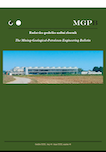Conceptual development of the transition from drill and blast excavation to non-blasting methods for the preparation of mined rock in surface mining
DOI:
https://doi.org/10.17794/rgn.2019.3.3Keywords:
non-blasting development, mechanical ripping, mining equipment, elements of the mining system, hard mined rocksAbstract
This article is devoted to the conceptual development of the transition from drill and blast excavation to a non-blasting method for the preparation of hard rock before excavation at construction material deposits. The scientific and technical literature on the problems in the blasting of hard rock in preparation for excavation is analysed. A classification of mining equipment for the non-blasting development of a rock mass for excavation has been developed, taking into account the nature of the operation of mining equipment. The concept of the transition from drill and blast excavation to non-blasting methods in the preparation of mined rock in non-metallic material quarries is presented. The research results of the parameter determination of the elements of the system for the development of non-blasting equipment at a limestone quarry are presented. The economic efficiency of a hydraulic excavator with a ripper tooth for developing limestone with a strength of up to 30 MPa is established.
Downloads
Published
How to Cite
Issue
Section
License
Copyright (c) 2019 authors and journal

This work is licensed under a Creative Commons Attribution 4.0 International License.
Creative Commons-BY
Authors who publish with this journal agree to the following terms:
In agreeing this form, you certify that:
- You read the ethical codex of the RGN zbornik available at journal web.
- You submitted work is your original work, and has not previously been published and does not include any form of plagiarism.
- You own copyright in the submitted work, and are therefore permitted to assign the licence to publish to RGN zbornik.
- Your submitted work contains no violation of any existing copyright or other third party right or any material of an obscene, libellous or otherwise unlawful nature.
- You have obtained permission for and acknowledged the source of any illustrations, diagrams or other material included in the work of which you are not the copyright owner.
- You have taken due care to ensure the accuracy of the work, and that, to the best of your knowledge, there are no false statements made within it.
- All co-authors of this submitted work are aware of, and in agreement with, the terms of this licence and that the submitted manuscript has been approved by these authors.
Publication licence
You retain copyright in your submitted work, according to journal license policy (CC-BY). By signing this form you agree that RGN zbornik may publish it under the publication licence. In summary the licence allows the following:
Anyone is free:
- To copy, distribute, display, and perform the work.
- To make derivative works.
Under the following conditions:
- The original author must always be given credit.
- The work may not be used for commercial purposes.
- If the work is altered, transformed, or built upon, the resulting work may only be distributed under a licence identical to this one.
Exceptions to the licence
In addition to publishing the work printed under the above licence, RGN zbornik will also enable the work to be visible online.
The journal editorial can change the licence rules anytime but it cannot retroactively restrict author(s) rights.


